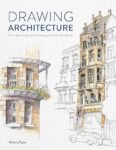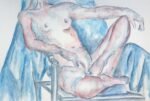Time for another book review. This is Eddie Armer’s book on drawing hands and feet. Because hands and feet let me down so often in my figure drawing (and maybe because on PAOTY they like an artist who can draw hands) I thought I could do with a book like this in my collection. I liked the look of both Eddie’s book and that by Ken Goldman but definitely didn’t need both, so added Eddie to the wishlist and he landed on the bed on my birthday a couple of days ago. But will he make a difference? Read on.
First up, page count. This is quite a skinny one, a 96 page paperback. To be fair, the price of the book normally reflects this. And the book is on quite a niche subject, so it’s going to struggle to make it to 144 pages without going off at a tangent. And I’m picky when it comes to tangential bonus pages. Abstractification of ideas in the rest of the book yes, extending the medium in the book into mixed media no.
For me, the book separated out into three sections:
– 30 pages of introduction including materials, the structure of the hand and foot and an introduction to life drawing techniques
–16 pages on the basics of drawing the hand and foot face on
– 50 pages on more complicated drawings, including perspective, gesture, holding objects, clothing, etc
If this sounds like a weird way to divide up the book, it’s because it’s the quality of the advice that I’ve based this on and not the subject matter. Believe me, if you read this book you’ll notice this division.
So, yes, that first 30 pages wasn’t of too much interest to me. There was some interesting stuff, though, on materials and preparation for anyone that likes to draw with graphite pencils. And a two page spread that I liked that neatly summarised five things to be looking for when drawing by eye: five things that I knew about and that could easily be five chapters in a book somewhere but that I appreciated seeing all at once on a two page spread. It makes things easier to remember.
Then we get to the meat of the book. Sixteen pages that go through how to draw the back of the hand, the front of the hand and the bottom of the foot in detail. It’s all very methodical with rectangles outlining shapes and instructions about where to divide them up into halves, thirds, etc. At the end of these sixteen pages, I felt that I understood the hand and foot a lot more. In particular, the big learning point for me was how different the back and front of the hands are. The fingers look longer from behind than they do in front! And the creases on the front don’t line up with the knuckles on the back. I had a go at drawing a hand from the front and from the back and was amazed at the difference that this book was already making.
And then we get to the last 50 pages where we look at hands and feet from other angles and at hands that weren’t perfectly straight. There’s still lots of useful stuff here but it felt to me that the energy dropped. After all the attention to detail in the sixteen pages of gold, things started to feel a bit rushed. It also started to feel more like general advice on drawing or figure drawing with hands and feet as examples rather than advice on drawing hands and feet.
I’m going to give this one three palettes because I think it’s worth the money and because I’d buy it again if I lost it. The most interesting stuff is concentrated into 16 pages but they’re gold dust and this is a pretty cheap book.
🎨🎨🎨









Leave a Reply